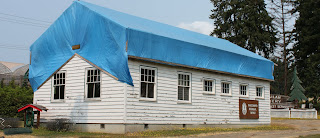 |
| Mayo Shay No. 3 next to the much smaller No. 9. Photo by Marcie Callewaert. |
No. 3 was built in 1924 and originally purchased for $16,000. It is a type “B” Class 50-2 (50 ton 2-truck) locomotive. Its weight in working order is 121,000 pounds. No. 3 is in operating condition but is a a standard gauge locomotive, meaning it cannot run on our narrow gauge tracks. The locomotive used superheated steam and featured an enclosed steel cab.
In 1995, museum staff restored the locomotive to working order in preparation for its loan to the (then) Kettle Valley Railway Historical Society. At that point the locomotive was converted to burn oil instead of wood. In September of 2009, the Mayo Shay returned to the BCFDC and was met by a happy crowd of staff, volunteers and visitors.
The Mayo Shay presented quite an impressive sight as it was brought in on a low-bed trailer, imagine driving in traffic beside it!
 |
| Parked on Drinkwater Road in front of the BCFDC |
Crane Force donated their time, equipment and expertise to unload No. 3 at the museum
Photos by Aimee Greenaway.
Photos by Aimee Greenaway.



































